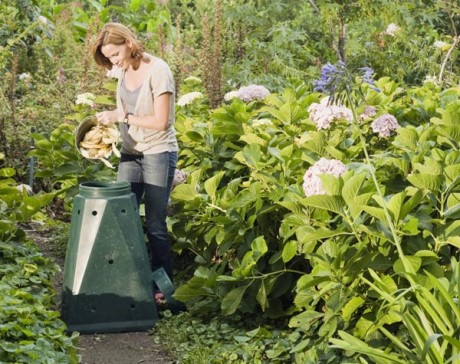Black Gold
Turn scraps and yard waste into useful compost
Grass clippings. Banana peels and orange rinds. Wood chips. Shredded paper and cardboard. Raked leaves. Dryer lint. What do all these have in common? They are organic materials that can easily and inexpensively be combined to create a product useful in your yard, garden and landscaping endeavors: compost.
Approximately 27 percent of the waste that makes its way into landfills is organic, mostly food remnants and yard waste. Not only does organic matter take up space, but it also generates methane gas and leachate (water produced by the decomposition of items containing carbon that becomes contaminated as it travels through the solid waste in a landfill), both of which can be harmful to the environment. Turning organic matter into compost, however, has many benefits — improving and enriching garden soil, helping to retain moisture and reduce the need for watering, and providing nutrients in a medium that requires little or no added fertilizer or pesticides. And, did I mention that it's free?
What is compost? It is essentially organic matter that has been compiled and then decomposed (hence the name: compost) over time. Fungi, bacteria, worms and heat each help to facilitate the decomposition process. You can use a commercial bin, of which there are several types available, a pile, or if your space is limited, you can even use an indoor bin with worms, called vermicomposting. Bins are best if you would like to incorporate food items. An ideal location for a pile has some shade and is approximately one cubic yard (three feet wide by three feet deep by three feet high), but larger or smaller piles will also work.
The best method involves mixing the ingredients in the pile or bin so that dry ingredients come into contact with wet ingredients. Turning or stirring isn't necessary, but it will help add oxygen for the organisms in the pile, speeding decomposition and reducing odors. The proper moisture content to maintain is about that of a damp sponge. Shredding food scraps and lawn waste into small pieces helps them break down faster, while burying food waste under eight to 10 inches of compost aids in decomposition and helps to reduce any unpleasant smells that may attract rodents or even bears. To speed composition, add greens (nitrogen); to avoid odors, add browns (carbon).
Compost is ready to use when it is dark colored and contains no visible food remnants or yard waste. It may be placed around landscape trees, incorporated into your garden soil, or used to fertilize your lawn or planting beds. Whichever way you choose to use your black gold, it will improve your soil and benefit the plant life it supports, while helping to recycle your waste and conserving landfill space.
Compost is relatively easy to make — just add the four key ingredients — and nature will do the rest! Carbon and nitrogen, plus air and water. A ratio of about 30:1 carbon to nitrogen is desirable, but the pile will work without it being exact; the key for a faster decomposition is simply more browns than greens.
Carbon (brown materials): shredded newspaper and junk mail, dry leaves, nut shells, crumbled egg shells, dryer and vacuum cleaner lint, wood chips, branches and twigs with a diameter of ¼ inch or less, and cardboard rolls.
Nitrogen (green materials): fruit or vegetable remnants (cooked or raw), breads and grains, coffee grounds and filters, grass clippings, tea bags, hair and fur, and green leaves.
Certain items that should not be added to your compost bin or pile include meat or dairy items.
Resources
Visit your local Cooperative Extension office.
U.S. EPA publication "Backyard Composting: It's only natural," found at www.epa.gov/epawaste/conserve/rrr/greenscapes/pubs/compost-guide.pdf
-
Share this story:



